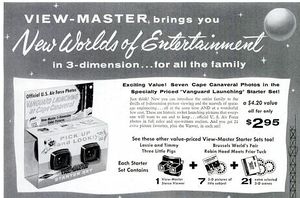Difference between revisions of "Viewmaster"
(→Military Training) |
(→Reels & Offshoots) |
||
| Line 22: | Line 22: | ||
After the war, demand for viewmasters shot through the roof, and the production of reels for entertainment purposes began. | After the war, demand for viewmasters shot through the roof, and the production of reels for entertainment purposes began. | ||
| − | === | + | ===Talking Reels=== |
| − | + | ||
| + | ===View Master Projector === | ||
==Economic Perspective== | ==Economic Perspective== | ||
Revision as of 12:25, 4 October 2010
The Viewmaster is a personal stereo camera, popularized in contemporary culture as a children's toy for viewing 3-D images. It has enjoyed a variety of uses since its introduction in 1939, ranging from military training to tourist memorabilia. While its applications have changed in the seven decades it has been produced, the technology has largely remained the same, circumventing some issues of compatibility.
Contents
Timeline
Development
The Viewmaster device began when William Gruber developed a camera capable of taking stereo photographs and drew the support of Harold Graves, president of Sawyer’s Photographic Services. Sawyer’s had previously been focusing on scenic postcards and saw the stereographic photos as a unique opportunity. When Gruber and Graves introduced the Viewmaster at New York’s World Fair in 1939, it was meant as an alternative to the scenic postcards in which Sawyer’s had specialized. Originally intended to enhance science and education, the role of the commercialized Viewmaster morphed.
Applications
Reels & Offshoots
Military Training
During World War II, the U.S. Government and the War Department agreed to a contract with the viewmaster company to produce millions of different types of viewmaster reels to train the U.S. Armed Forces, more specifically the navy and army. In the army, reels consisted mainly of gun range values, as well as models of Italian, British, Russian, Japanese, and German aircrafts. Several reels also included U.S. aircrafts to help servicemen become familiar with their own models. Army reels also portrayed potential landing regions in various countries to familiarize soldiers with possible deployment locations. The Navy also utilized viewmasters, mainly to portray planes and ships from America and from other nations so that servicemen could more easily spot opposing forces. Popular reels used by the navy included the North American “Mustang” (a P-51 U.S. Army fighter plane), the Heinkel “He. 113” (German Fighter plane), the Fairey “Barracuda” (British Torpedo Bomber), and the Mitsubishi “Sonia” (Type 96 ALB-R Japanese Light Bomber). After the war, demand for viewmasters shot through the roof, and the production of reels for entertainment purposes began.
Talking Reels
View Master Projector
Economic Perspective
Modern Production & Enthusiasts
Nostalgia
Contemporary Testimonial
"I bought 5 of these for my little cousins, ages 3-5 for Christmas. The little ones (the 3 yr olds) really enjoyed this gift and their parents (my first cousins) appreciated the nostalgia. The 5 yr. olds were bored quickly. I purchased just the ViewMaster itself and then found reels at an online specialty toy company that had a huge selection and the reels were slightly less expensive too. The ViewMaster seems smaller than I remember, but it could be that my head got bigger since I last used mine! They all arrived nicely boxed and were all in good working order." - Amazon Review, 2008
Decline of the Viewmaster
Currently ‘Model O’ is in production, but the basic design behind the product hasn’t changed much in the 70+ years and 1.5 billion viewers sold since its invention. Sales have dropped off and some estimate that the product only brings in 10 million per year, causing the arm devoted to scenic reels to be amputated.
The Future for Viewmasters
While the Viewmaster may no longer be the flavor of the week, it has established a following of enthusiasts and drawn on the nostalgia of a user-base that is now in their adulthood. In July 2009, Dreamworrks Studios announced its intention to buy the movie rights to the Viewmaster with the intent of making a family-friendly film based on the popular children’s toy. The film will be written by Brad Caleb Kane and produced by Roberto Orci and Alex Kurtzman, of Transformers’ fame. Its release date is tentatively set for 2012.
References
Distefano, Anne Marie. "A View-Master View of Anatomy." The Trib Online. The Portland Tribune, 02 July 2009. Web. 03 Oct. 2010. <http://thetribonline.org/features/story.php?story_id=124648069540255500>.
Happy Gifter. "Classic Model L Was a Hit with the 3 Yr. Olds." Amazon.com: Online Shopping for Electronics, Apparel, Computers, Books, DVDs & More. 29 Dec. 2008. Web. 04 Oct. 2010. <http://www.amazon.com/ViewMaster-Classic-Model-Blue-Viewer/dp/B000K65NU6/ref=sr_1_2?s=toys-and-games&ie=UTF8&qid=1286148679&sr=1-2>.
Inventors of the Viewmaster. Photograph. Web. 3 Oct. 2010. <http://www.eighties.fr/jeux-et-jouets/359-view-master.html>.
Kit, Borys, and Jay A. Fernandez. "DreamWorks Eyes View-Master Pic | DreamWorks Studios." Home | DreamWorks Studios. The Hollywood Reporter, 06 July 2009. Web. 04 Oct. 2010. <http://dreamworksstudios.com/news/dreamworks-eyes-view-master-pic>.
20th Century Stereo Viewers - Www.viewmaster.co.uk. Web. 04 Oct. 2010. <http://www.viewmaster.co.uk/index.asp>.
"View-Master | National Toy Hall of Fame." Home | National Toy Hall of Fame. Web. 04 Oct. 2010. <http://www.toyhalloffame.org/toys/view-master>.

